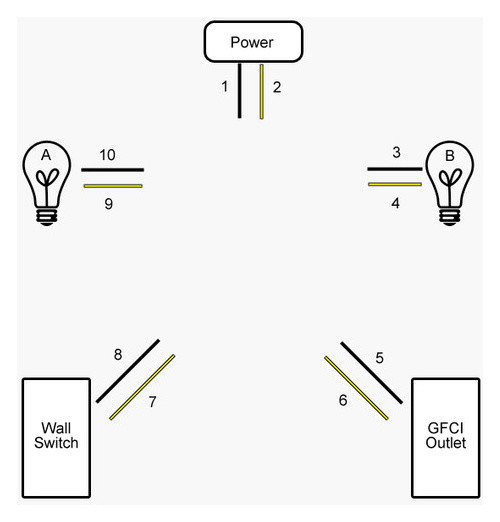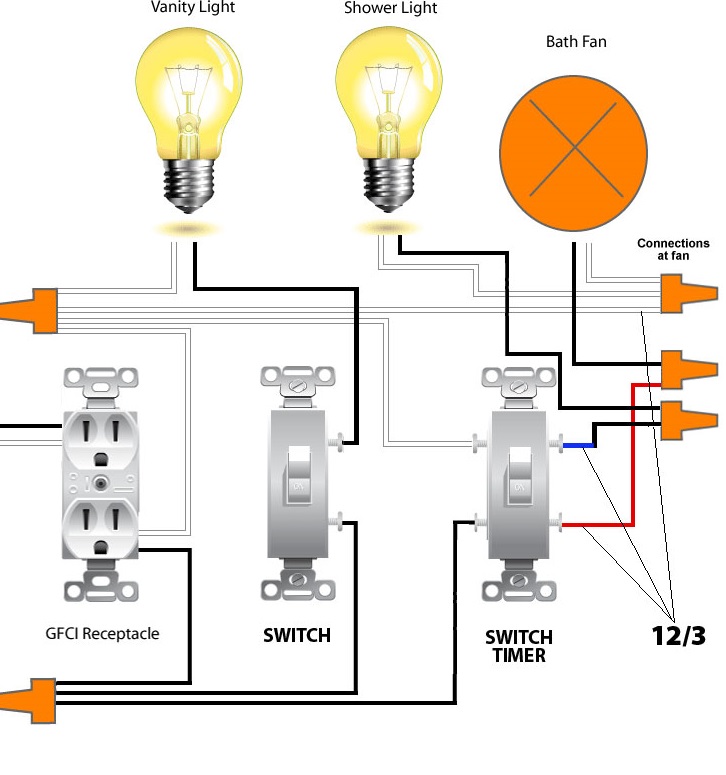When planning the electrical layout for a bathroom, the placement of lights and outlets on the same circuit is a common consideration. While it’s not inherently wrong to have lights and outlets on the same circuit in a bathroom, there are certain factors to keep in mind to ensure safety and functionality. The National Electrical Code (NEC) provides guidelines for electrical installations, including those in bathrooms, to minimize the risk of electrical hazards.
One important consideration is the load on the circuit. Lights typically have a lower power requirement compared to outlets, which may be used to power appliances such as hair dryers, curling irons, or electric razors. It’s crucial to ensure that the combined load of the lights and outlets on the circuit does not exceed the capacity of the circuit breaker or fuse protecting it. Overloading a circuit can lead to overheating and potentially cause a fire hazard.
Another consideration is the type of outlets installed in the bathroom. Ground Fault Circuit Interrupter (GFCI) outlets are required by code in bathrooms to protect against electrical shock in wet environments. GFCI outlets should be installed at every outlet location in the bathroom, including those on the same circuit as the lights. This provides an added layer of protection against electrical hazards by quickly shutting off power if a ground fault is detected.
Proper wiring and insulation are also essential when lights and outlets are on the same circuit. Wiring should be installed according to code requirements, with appropriate wire gauge and insulation to handle the load and protect against overheating. It’s essential to use moisture-resistant wiring and electrical boxes in bathrooms to prevent damage from moisture and humidity.
Additionally, the placement of switches and outlets should be carefully planned to ensure convenience and accessibility. Light switches should be located near the entrance to the bathroom for easy access, while outlets should be strategically placed for convenience and safety. Outlets should be positioned away from water sources to minimize the risk of electric shock.
Regular maintenance and inspection of the electrical system in the bathroom are crucial for ensuring continued safety and functionality. Periodically checking for signs of wear or damage, such as frayed wires or loose connections, can help prevent electrical hazards. If you encounter any issues or have concerns about the electrical wiring in your bathroom, it’s best to consult with a licensed electrician for guidance and assistance.
While it is common to have lights and outlets on the same circuit in a bathroom, careful planning and adherence to electrical codes and safety standards are essential. By ensuring proper load distribution, installing GFCI protection, using appropriate wiring and insulation, and planning the placement of switches and outlets, you can create a safe and functional electrical system in your bathroom. Regular maintenance and inspection are key to identifying and addressing any potential issues before they become safety hazards.
How do I wire multiple switches for my bathroom lights and fan
Bathroom Branch Circuits in the 2020 NEC u2013 JADE Learning
210.11(C)(3) Bathroom Branch Circuits.
Electrician Bathroom Wiring Meyer Electrical Services, Inc.
Image result for wiring outlets and lights on same circuit
How to wire two lights and an outlet on the same circuit
Electrical Wiring Needed for a Bathroom
Circuit and wiring check and install inquiry for bathroom light
Q. Can the lights in a dwelling unit bathroom be on the same
Bathroom wiring diagram DIY Home Improvement Forum
How to GFCI protect bathroom lighting circuit – Home Improvement
Home electrical wiring, Bathroom exhaust fan, Electrical wiring
Related articles:
- Antique Bathroom Light Fixtures
- Bathroom Lighting Inspiration
- Modern Bathroom Lighting
- Bathroom Lighting Above Vanity
- Small Bathroom Lighting Layout
- Rustic Bathroom Sconce Lighting
- Farmhouse Style Bathroom Light Fixtures
- Modern Bathroom Lighting Design
- Bathroom Ceiling Lighting Fixtures
- Modern Bathroom Lights Over Mirror
Bathroom Lights And Outlets On the Same Circuit: Is It Safe?
When it comes to electrical wiring in your home, safety should always be a top priority. One common question that homeowners have is whether it’s safe to have bathroom lights and outlets on the same circuit. In this article, we’ll explore this topic in detail, including the pros and cons, how to determine if your wiring is up to code, and tips for staying safe.
Pros And Cons Of Bathroom Lights And Outlets On Same Circuit
There are several advantages to having bathroom lights and outlets on the same circuit. One of the biggest benefits is convenience – you can easily turn on the lights and use your hair dryer or electric razor without having to switch between different circuits.
Another advantage is cost savings. Running separate circuits for each fixture in your bathroom can be expensive, especially if you’re remodeling or adding new features like heated floors or a spa tub. By combining lights and outlets on one circuit, you can save money on installation costs.
However, there are also some potential drawbacks to consider. One of the biggest concerns is safety. Combining lights and outlets on the same circuit increases the risk of overloading the circuit if too many appliances are used at once. This can create a fire hazard or cause damage to your electrical system.
Additionally, if you have GFCI (ground fault circuit interrupter) outlets installed in your bathroom, they may trip frequently if both lights and outlets are connected to the same circuit. This can be inconvenient if you’re in the middle of styling your hair or using an electric toothbrush.
How To Determine If Your Wiring Is Up To Code
If you’re unsure whether your bathroom lights and outlets are on the same circuit, or if your wiring is up to code, it’s best to consult with a licensed electrician. They can inspect your electrical system and make recommendations for any necessary upgrades or changes.
In general, however, some general guidelines can help you determine if your wiring is up to code. According to the National Electrical Code (NEC), all bathroom outlets must be GFCI-protected and on a circuit of their own, or on a circuit that only serves bathroom fixtures. Additionally, bathroom lighting fixtures must be rated for use in wet locations.
If your bathroom lights and outlets are on the same circuit, it’s important to ensure that the circuit is not overloaded by using too many appliances at once. This can be done by adding additional circuits or upgrading your existing electrical panel.
Tips For Staying Safe
To ensure the safety of your bathroom electrical system, there are several precautions you can take:
Use GFCI outlets: GFCI outlets are designed to protect against electrocution by automatically shutting off power when they detect a ground fault. All bathroom outlets must be GFCI-protected by code.
Limit appliance use: To avoid overloading your circuit, try not to use too many appliances at once. For example, if you’re blow-drying your hair, turn off other appliances like curling irons or electric razors.
Upgrade your electrical panel: If you’re adding new features like heated floors or a spa tub, you may need to upgrade your electrical panel to accommodate the additional load.
Hire a licensed electrician: If you’re unsure about the safety of your electrical system or need help making upgrades, it’s always best to consult with a licensed electrician.
Can I install bathroom lights and outlets on the same circuit myself?
A: It is not recommended that homeowners attempt to install electrical wiring themselves due to the risk of electrocution and fire hazards. Always hire a licensed electrician for any electrical work.
How do I know if my bathroom lights and outlets are on the same circuit?
If you’re unsure whether your bathroom lights and outlets are on the same circuit, consult with a licensed electrician. They can inspect your electrical system to determine how it is wired.
What should I do if my GFCI outlets keep tripping?
If your GFCI outlets keep tripping, it may be a sign that there is an issue with your electrical system. Consult with a licensed electrician to diagnose and fix the problem.
Can I add new features like heated floors or a spa tub to my existing bathroom circuit?
It depends on the capacity of your existing electrical panel and wiring. Consult With a licensed electrician to determine if your current system can handle the additional load, or if upgrades are necessary. It’s important to ensure that your electrical system can safely support any new features you want to add.
Do I need special lighting fixtures for my bathroom?
Yes, bathroom lighting fixtures must be rated for use in wet locations. This helps to prevent electrocution and reduce the risk of fire.
What should I do if I experience an electrical shock in my bathroom?
If you experience an electrical shock in your bathroom, seek medical attention immediately. It’s also important to have a licensed electrician inspect your electrical system to determine the cause of the shock and make any necessary repairs.











